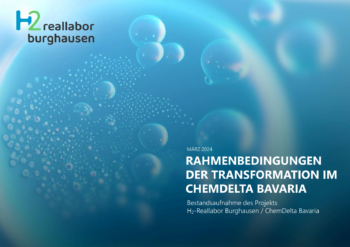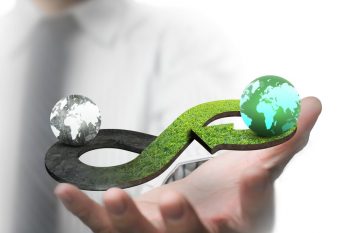Series of articles Carbon Management: What does carbon management mean?
With the European climate neutrality targets for 2050 firmly in place, carbon management is moving into the focus of sustainable environmental practices. The challenge is not only to reduce emissions, but also to effectively manage unavoidable emissions. This requires the use of carbon capture technologies that enable either underground storage (Carbon Capture and Storage – CCS) or integration into a closed carbon cycle (Carbon Capture and Utilization – CCU). This series of articles provides an overview of carbon capture technologies, possible utilization of CO2, storage methods, transportation options and political efforts in the context of carbon management.
Contents of the article series
- Explanation of terms and basics
- How are captured emissions accounted for?
- How can CO2 be captured?
- CCU – How can CO2 be utilised?
- CCS – How can CO2 be stored?
- How can CO2 be transported?
- What framework conditions need to be considered?

Background information
The EU has set itself the goal of becoming climate-neutral by 2050. Measures are therefore being taken in all sectors to reduce existing emissions. In industry, too, CO2 emissions are being reduced through transformation measures such as electrification, the use of climate-neutral fuels and efficiency measures. In some branches of industry, however, there are not only energy-related emissions that can be reduced through the aforementioned transformation measures. In the cement and lime industry, for example, there are also process-related emissions caused by the raw materials used during the process. These process-related emissions are considered “unavoidable”. In order to achieve climate neutrality by 2050, these emissions must therefore be captured.
The term “carbon management” refers to all measures that are necessary to ensure the sustainable handling of difficult and unavoidable CO2 emissions. In particular, the collective term covers all steps in the value chain: carbon capture, transportation, storage and further utilization of CO2.
The carbon cycle
Figure 1 shows the various options following the capture of CO2 in a carbon cycle. One option is the long-term geological storage of CO2, known as Carbon Capture and Storage (CCS). Another option is the further utilization of CO2, for example for the production of plastics or synthetic fuels (Carbon Capture and Utilization – CCU).
If the CO2 is bound in synthetic fuels, it escapes during combustion of the fuel. The CO2 bound in plastics is also released again at the end of the product’s life, for example in waste incineration plants. In order to ensure a closed carbon cycle here, CO2 must be captured at waste incineration plants, which can then be geologically stored or reused.
In addition to industrial point sources, CO2 can also be captured at biomass power plants. As biogenic fuels have absorbed CO2 during their growth, CO2 capture at biomass power plants with subsequent storage (BECCS) leads to negative emissions. Direct air capture technology (DACCS), which is being tested in pilot projects, can also separate CO2 that has already been emitted from the ambient air and, when subsequently stored, serves to remove CO2 from the atmosphere.
Opportunities and challenges of CCU/S
The capture of unavoidable emissions is an important measure for achieving the climate neutrality targets in Europe. Capture from the air through Direct Air Capture (DAC) and the capture of biogenic CO2 with subsequent storage can contribute to climate neutrality through net CO2 reduction.
Both the CO2 capture itself and the synthesis for further utilization for the production of basic chemicals are associated with high energy consumption. The synthesis also requires a large amount of green hydrogen, which is likely to be in short supply and expensive. Nevertheless, the CO2-based production of basic chemicals is an important measure for the defossilization of the chemical industry. Although biomass could also supply the necessary carbon as a substitute for fossil sources, biomass is a limited resource and should therefore be used with caution. Nevertheless, the use of biomass is currently the preferred option for many players, as the financial incentives for a synthesis from green hydrogen and CO2 (CCU) are currently lacking.
There is still a need for development in both the capture, storage and utilization of CO2 in order to be able to use the technologies economically. Currently, however, the regulatory hurdles are the main challenges for a CCU/S ramp-up. Accordingly, the German Carbon Dioxide Storage Act prevents the storage of CO2 outside of “research, testing and demonstration” in Germany [1]. Moreover, further testing of storage facilities in a research context is currently not possible in Germany, as the application deadline for this expired at the end of 2016. According to the Carbon Dioxide Storage Act, however, pipeline-based transportation is tied to the purpose of transportation to storage facilities. Accordingly, the use of CO2 is currently possibility in Germany.
In the international context, the London Convention (1972) [2] and the associated Protocol (1996) prohibit the export of waste to non-Parties, which in its current form also includes the export of CO2. A corresponding additional clause from 2009, which allows the transboundary export of CO2 for storage in the seabed, will only come into force when two thirds of the contracting parties ratify it. By 2022, only eight out of 53 states have ratified this amendment – Germany is not one of them [3].
Once the aforementioned regulatory hurdles have been overcome, the experience gained in currently planned pilot projects such as Northern Lights, Aramis and the Northern Endurance Partnership can provide valuable insights for implementation in real operations.
Weitere Informationen
Literatur
[1] Gesetz zur Demonstration der dauerhaften Speicherung von Kohlendioxid (Kohlendioxid-Speicherungsgesetz – KSpG) (KSpG). Ausgefertigt am 2012-08-17, Version vom 2021-08-10; Berlin: Bundesministerium der Justiz, 2021.
[2] Convention on the Prevention of Marine Pollution by Dumping of Wastes and Other Matter (London Convention). Ausgefertigt am 1972, Version vom 2006; London: International Maritime Organization, 2006.
[3] Antrag der Fraktion der CDU/CSU: Offensive für CO2-Speicherung und -Nutzung einleiten (Offensive für CO2-Speicherung und -Nutzung einleiten). Ausgefertigt am 2023-03-28; Berlin: CDU/CSU, 2023.

